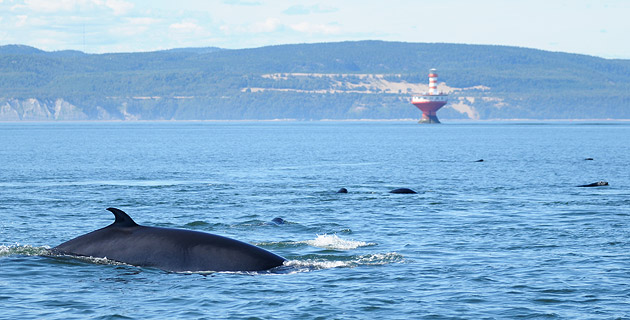“Good thing we at least have them!” joke several captains and naturalists from the Tadoussac – Les Escoumins region, referring to the numerous minke whales and the absence of large rorquals (fin whales, humpbacks and blue whales) in recent weeks.
Large rorquals or not, minke whales are fabulous to observe, especially when they’re hunting. Whether feeding amidst underwater cliffs, tide rips or even boats, they adapt to their environment and use it to trap fish.
Rorquals are “gulpers”, meaning they engulf huge quantities of water and prey at once before filtering out the water and swallowing the food. Thanks to their ventral grooves, their throat stretches like an accordion to bring as much water into their mouth as possible. It is believed these ventral grooves can even expand up to 162% in the circumference of the oral cavity and up to 38% in length during the engulfing manoeuvre (article in French)!
Four minke whales were feeding in Tadoussac Bay on June 18. We imagine the waters were teeming with their favourite small prey: capelin and herring! The same day, at the Baie-des-Sables wharf in the Gaspé Peninsula, an observer discovers three minke whales feasting themselves. On June 20, a high, straight spout led him to believe that a fin whale was offshore. Two fin whales are also spotted near Tadoussac on June 20.
In Sept-Îles, the huge spouts observed are indeed those of large large rorquals. Anik Boileau of the Sept-Îles Education and Research Centre (CERSI) mentions the presence of ten fin whales, five humpbacks and nearly a dozen porpoises. Photos taken during these outings are also available on the organization’s Facebook page.
In Gaspé, fog and wind force whale-watching companies to confine themselves to the bay for almost a week. Nevertheless, they manage to discover a minke whale, two fin whales and six humpbacks, including the familiar Bolt and Pseudo.
In the Gulf of St. Lawrence, over the Laurentian Channel, more precisely between the Magdalen Islands and Anticosti Island, a Fisheries and Oceans Canada crew on a mission aboard the Teleost discovers six right whales on June 15. Two fin whales are also nearby. The whales are feeding near the water surface. Unlike fin whales, right whales are not “gulpers”. They swim with their mouths wide open and filter water as they go along with their 3-metre long baleen, capturing zooplankton such as tiny crustaceans called copepods or krill. These globetrotters have arrived from a long migration that started in the coastal waters off Georgia or Florida.
Other remarkable migrants, harp seals are able to travel impressive distances – up to 8,000 km! – and they surprise more than a few observers in the Estuary with their noteworthy presence in the middle of summer! The majority of individuals head north, but hundreds remain in the St. Lawrence for the warmer months. It is not unusual for this species – deemed a “vagrant” because it is outside its traditional range – to be seen on the US east coast, England, Germany, France and even Spain.
This map represents an order of magnitude rather than a comprehensive survey.





